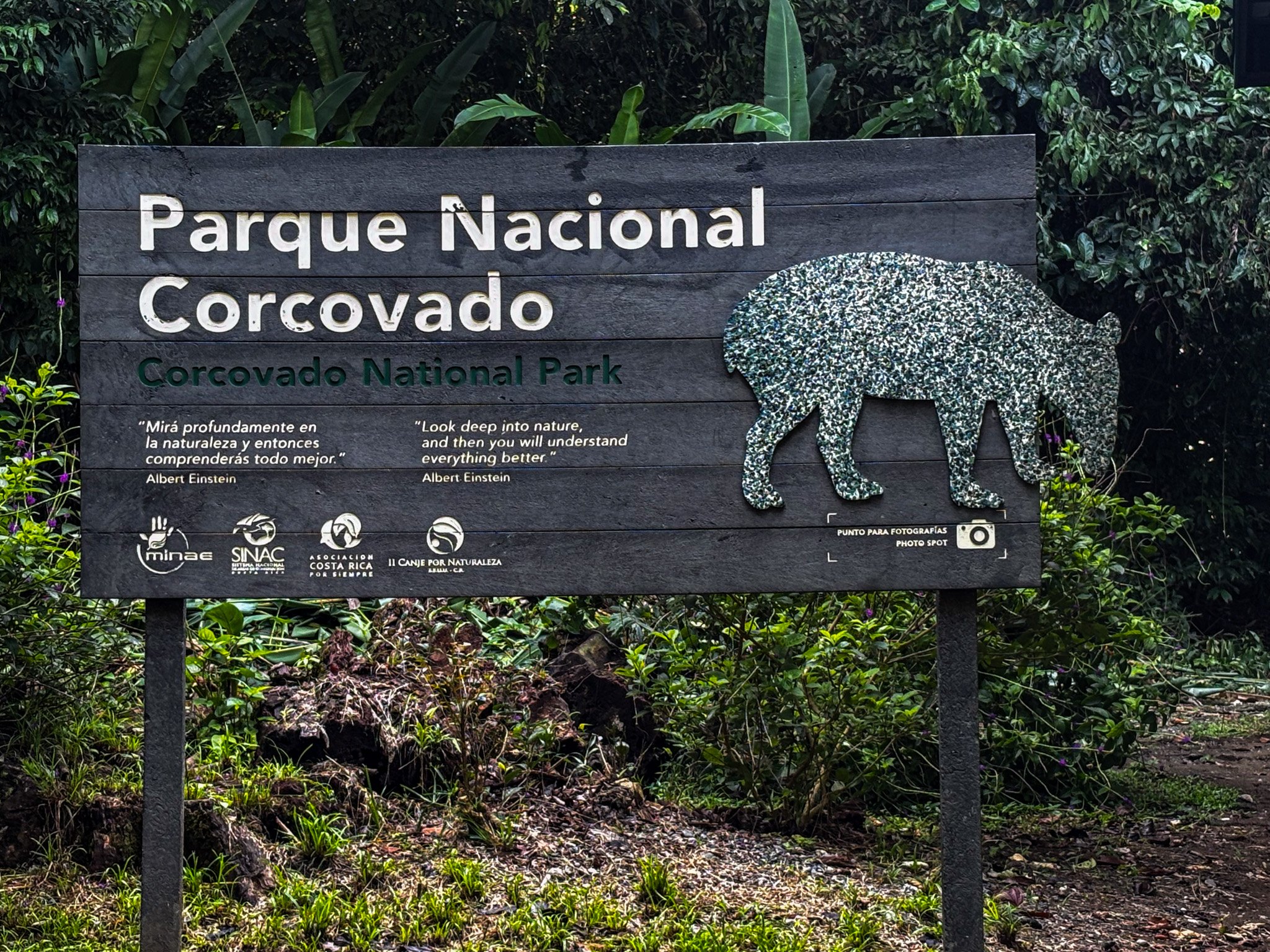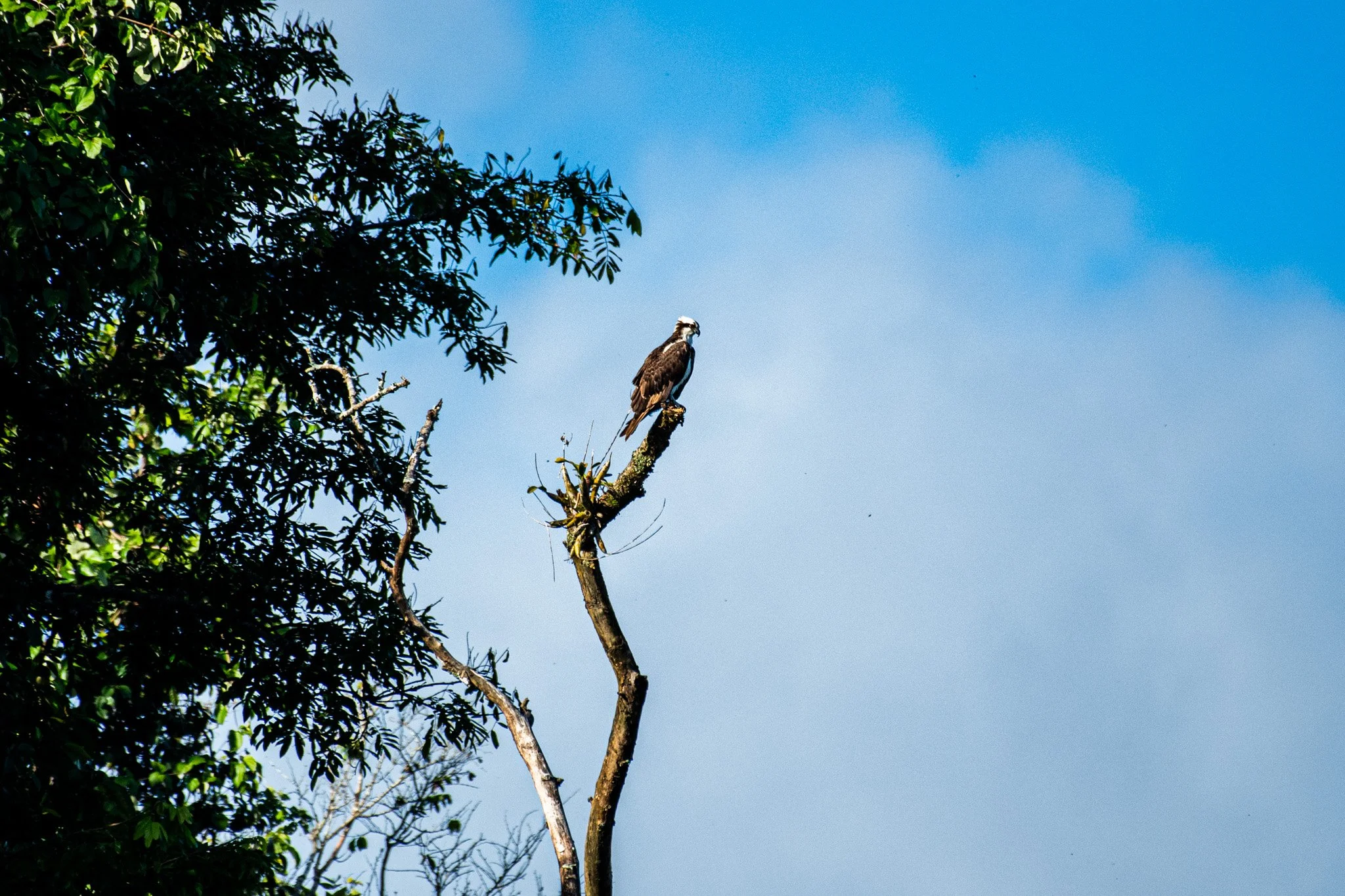Corcovado
There are two ways to get to Corcovado National Park: by boat or a very long hike. We chose the boat. We met Royer at 5am for a 6am departure from the docks. The boat ride is anywhere from an hour and a half to two hours depending what you see along the way. We boarded the small boat with several other tour groups and off we went. It was just after dawn and the misty jungle met the aqua blue surf, it really gave a Jurassic Park kind of vibe. Not much to see along the way we did stop at a rock outcrop to see a blue-footed booby but we were on a time crunch so the boat moved on. The national park has no dock so to get to land you need to get out directly into the water. Luckily it was high tide and we’d be offloading in the mouth of Rio Claro. Costa Rica is well known for its world class surf and as we approached the park the waves began to crest and crash. The boat captain turned toward shore and literally surfed the boat on the waves towards land. We got into the river without incident and disembarked in shallow water, avoiding getting soaked. I unpacked the camera from the dry bag and we began our hike through the park.
osprey
Corcovado is incredible. The pristine beaches that meet the jungle make you feel small and alone. Right from the start the howler and squirrel monkeys were overhead chattering, howling and moving through the canopy.. We did our best to avoid the other tour groups. The birds were everywhere mot mots, jacamars, curacaos, a trogon, and euphonias to start and we even saw some bats in a hollow tree.. The big attraction for Corcovado is the tapirs. We saw one pretty quickly but it was obscured by thick underbrush. Royer pushed on. After a short time we came to the “entrance” to the park where we checked in with our passports and pay. There's a small ranger office and bathrooms. After checking in we hit the trails looking for tapirs and anything else we could find. Royer located fresh tapir tracks that showed a mother and a baby. We followed these fresh tapir prints from the jungle out to the beach and then back in. We made it out to Rio Sirena and then turned back in to find other creatures.
Rufous-tailed Jacamar
Barred Antshrike
A short time later a northern tamandua (ant eater) walked next to us along the trail, scaled the tree at an effortless speed and disappeared into the canopy. Way cool. There we ran into some other guides who told Royer there was a tapir not far. Off we went. We got to the spot to find a tapir enjoying a mud bath. It was surrounded by spiny acacia trees which made the approach difficult. The tapir was unbothered by our presence. In an attempt to find a different angle to shoot from I inadvertently sat on a broken acacia branch. A real pain in my ass. After taking some pictures I took time to put the cameras away and just enjoy. This is one of our core principles: enjoy the scene not through the lens. The rain began slowly at first and by the time I worked my way out of the spine maze it was a torrential downpour. Part of the tour included lunch at Sirena research station which was 2 kilometers away. We trudged through the rain and made it to the research station. Sirena is no longer used by biologists and now serves as a lodge for tourists. An expensive stay but I would imagine it to be rewarding. After a lunch of rice and vegetables we grabbed some souvenirs, put our boots back on, popped some Dramamine and made our way down the deserted runway towards shore. Low tide meant that we now had to board the boat by wading out in thigh deep water to board. I should have taken off my socks first. Oh well. The boat ride back felt faster and I wish I had had more time in the park. Back at the cabin we repacked our luggage. We had just one last morning on the Osa Peninsula before our flight back north. Royer offered to take us on one last little adventure.
We woke early again and Royer took us back up to Rio Tigre where we had done our second night hike. We crossed the rickety bridge in the daylight this time. Royer was taking us to his mother’s house. A cow had died at her property and the king vultures had gathered there to feast. We were able to see several king vultures from the steep hills around the house. Aside from the views of the vultures the views of the peninsula and the gulf are stunning. After the vultures we went back to the cabin, said our goodbyes to Royer, dropped off the car at Enterprise and went to the “airport.” We grabbed a few more small souvenirs and waited for our flight. On the flight back we sat right behind the pilots which added a few more inches of leg room. The pilots spent the flight looking at a map of different parts of the US including Texas and Alaska. Maybe they were planning a trip? We landed and got picked up by the car service, stopped for lunch in San Jose and headed north to Monteverde. Two Dramamine for the winding mountain roads meant a nice 3-hour nap. We arrived at the Jaguarundi hotel around 5pm in the pouring rain and were shown to our cabin room up the steep hill from the reception building. Dinner at the hotel next door, Ficus hotel. Dinner was fantastic steaks and good drinks. After a long day of travel and exploring we went to bed early with plans to meet another guide in the morning.







